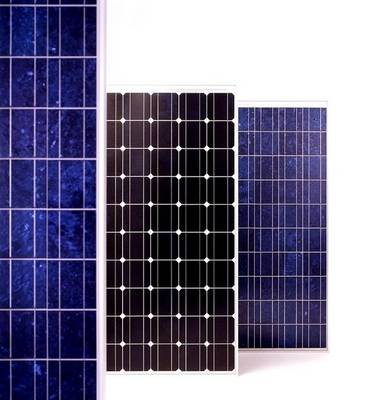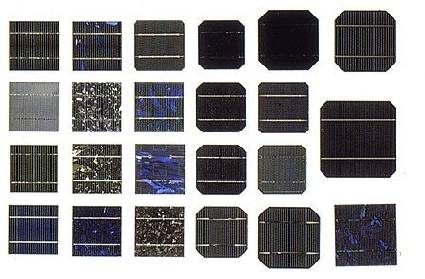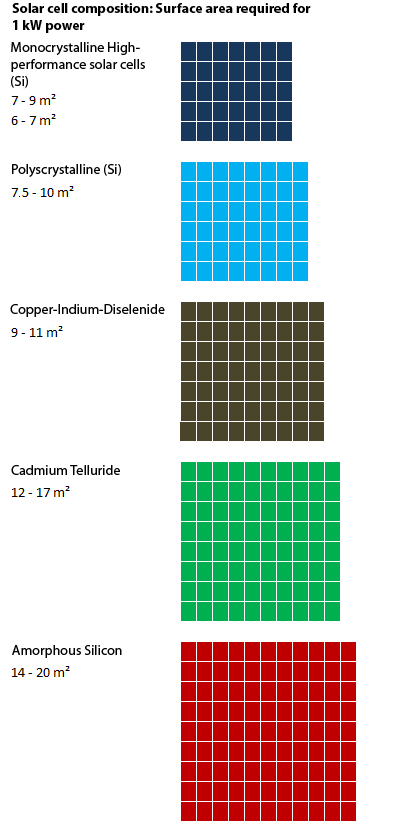Do-It-Yourself Solar-Powered PC: Technical Foundations
Solar Cell Types: Up To 25% Efficient
Industrial-grade solar modules from Sharp come in mono- and polycrystalline forms
Each solar array panel includes a total of 36, 72, or even 96 individual standard solar cells. In the recent past, cell sizes have attained nearly 5" square (125mm) dimensions. The most commonly used type of solar cells are made of thick-film silicon, whose efficiency ratings go up to relatively high values of 20 percent for polycrystalline cells, and up to 25 percent for monocrystalline cells. In the still relatively brief history of solar cell technology, many types of solar cells have been developed, all of which differ in terms of how panels may be contructed and how well they convert solar energy into electricity. For industrial and home use for participation in the power grid, solar cells made of monocrystalline or polycrystalline silicon are most commonly used. The lower efficiency ratings for polycrystalline silicon are more or less offset by their lower costs. The preceding photograph shows the relative surface areas required to generate 1000 Watts of electricity for the various types available.
Solar arrays made from amorphous silicon can be mounted as a leisure time activity. The thin-film technologies known as CIS (Copper Indium diselenide) and Cadmium-Tulluride (CdTe) only command about a 2 percent marketshare at present. But solar panels made of these materials enjoy some considerable advantages when compared to those made of crystalline silicon. First and foremost, they are about 100 times thinner than crystalline materials, which makes their packaging much thinner as well. It's also the case that thin-film solar panels can utilize diffused or weak sunlight - as when the sky is obscured by clouds - much more efficiently than crystalline modules. This makes the thin-film modules much more tolerant of partial shade as well. Another advantage comes from their tolerance for higher operating temperatures, typical in areas that receive ample sunlight. But thin-film panels have their disadvantages as well: to achieve the same levels of energy output as thick-film modules, they require larger surface areas for energy collection and generation.
Various types of solar cells, including monocrystalline and polycrystalline thick-film Silicon all the way through thin-film types
Energy efficiency for thick-film solar cells
- monocrystalline silicon 25%
- polycrystalline silicon 20%
Energy efficiency for thin-film solar cells
- amorphous silicon 10%
- CdTe 16%
- CIS/CIGS 20%
- nanocrystalline Si 10%
- micro-/polycrystalline Si 10%
- polymerous Si 5%
In actual use, cells are connected in series, to accumulate sufficient voltage from the 0.6V that a standard cell delivers to deliver usable voltage levels. Industrial grade solar modules are built from individual cells, interconnected with wiring and sandwiched between glass plates and polymer films for protection. Thin-film cells are also available in large interconnected arrays, sometimes even in auto-positioning carriers.
Get Tom's Hardware's best news and in-depth reviews, straight to your inbox.
The size of the surface area required to deliver 1,000 Watts depends on the material used for solar cell construction
For thick-film cells, mechanical carriers and photovoltaically active materials are the same. These cells are manufactured in much the same way as CPUs and graphics chips are made, using silicon wafers.
Current page: Solar Cell Types: Up To 25% Efficient
Prev Page 1,800 Hours Of Annual Sunlight Next Page Industrial-Grade Solar Cell Vendors

